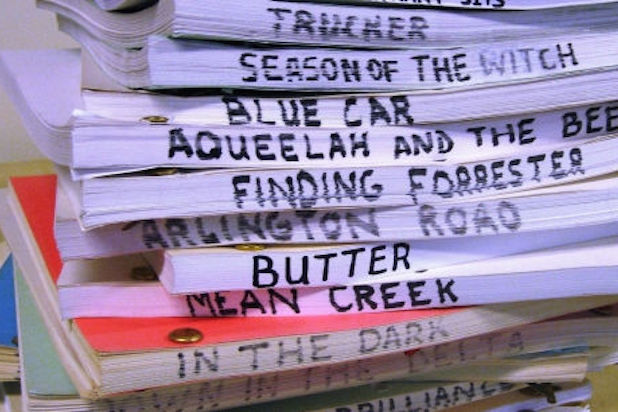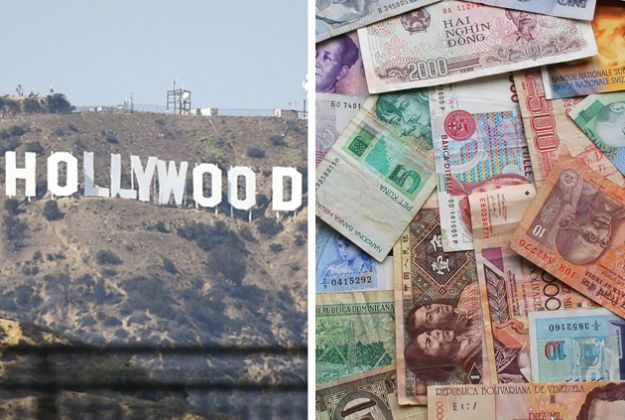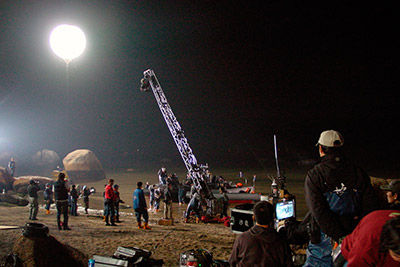Why Every Screenwriter Should Have One Low Budget Screenplay Written (Part 4)
- Screenwriting Staffing

- Mar 17, 2020
- 19 min read
Updated: Apr 25, 2023

Article 4 of our 10-part Screenwriting Staffing Industry Series will focus on the importance of having a low-budget screenplay in your arsenal. To stay current, join our mailing list.
Want to break into Hollywood?
Then you better have at least one low-budget spec script written. If not six!
Before diving in, I'd like to emphasize the importance of every writer having a single, high-budget screenplay in their collection. This script should not be constrained by budget, location, or cast size considerations. It's the kind of story that can launch a career, potentially earning six or even seven figures. Take Diablo Cody, for example, a first-time screenwriter who sold her spec for JUNO at an astonishing price. It's entirely possible!
The first screenplay I authored, titled COLOR BLIND, necessitated an extensive budget. Set in Chicago between 2004-2005, the story unfolds during the White Sox's World Series victory. Producer Christian Peschken (Dillinger and Capone, The Spy Within) immediately optioned the script and secured a first-look deal with Warner Bros. However, after an 18-month option period, the project remained unproduced. Despite this, the script has proven valuable as a writing sample, and has placed in several contests
So, if you haven’t already, write your best story. The sky is your limit, don’t hold back.
Then, put it away.

Before we begin, let’s describe what constitutes as low-budget. American Film Market and Stephen Follows submit to these numbers when defining what constitutes as micro/low-budget:
Micro-Budget in US: UNDER $400K
Low Budget in US: UNDER $2MM
Micro-Budget in UK: UNDER $150K
Low-Budget in UK: UNDER $350K
These numbers are even lower in places like Asia and South America.
After running Screenwriting Staffing, a site that fields screenplay requests on a daily basis, I would side with UK’s numbers as a more accurate figure. It's uncommon for an independent producer to contact me in search of a low-budget script with a budget of $2MM. If they have a budget of $2MM, they would likely refer to their search as seeking a script for a "moderate budget".
Throughout this series, I will be utilizing the figures from the UK as I and many of my colleagues consider them to be the most precise.
OKAY -- so, every screenwriter needs a low-budget script. But not just any low-budget script, I’m talking about a heavily contained screenplay with little to no special effects.
For starters, the script needs to be set in one location (two at the very max). I have participated in various screenwriting panels and workshops where I discussed this very exact topic.
The overwhelming response: it can’t be done. This is argued even by those with whom I am on a panel.
I then introduce a few 1 LOCATION gems they may be familiar with:
ROPE -- directed by Alfred Hitchcock
12 ANGRY MEN -- nominated for 3 Oscars
DEVIL -- written by M. Night Shyamalan
BURIED -- stars Ryan Reynolds
PANIC ROOM -- directed by David Fincher
REAR WINDOW -- nominated for 4 Oscars
MISERY -- won an Oscar
SAW -- directed by James Wan
HUSH -- directed by Mike Flanagan
BREAKFAST CLUB -- directed by John Hughes
WOMAN IN THE DUNES -- nominated for 2 Oscars
PARANORMAL ACTIVITY -- the most profitable film ever made, based on ROI.
(NOTE: a couple had “2” locations)

Not only are these 12 films a small sample, as there are possibly thousands more, but they are not ordinary films made by inexperienced filmmakers. Rather, they are crafted by some of the most skilled artists in the history of cinema, which has been recognized by the Oscars as well.
This concept is not new. Take the movie ROPE. It was released in 1948. That’s over 70 years ago!
There is this myth that one location scripts only work in the horror genre. According to IMDb, only 4 of the 12 films I listed are classified as HORROR.
Breakfast Club is arguably one of the best coming-of-age comedies in the history of cinema.
Once I mention these movies on the panel, I usually follow up with the notion that a low-budget, single-location script should feature a minimal cast of 10 or fewer actors, ideally 5.
That’s when everyone in the audience starts squirming in their seats.
I then list a few highly-successful films that had an incredibly low cast size (one as low as two):
MY DINNER WITH ANDRE -- directed by Louis Malle (4 characters)
GRAVITY -- won 7 Oscars (7 characters)
WHO’S AFRAID OF VIRGINIA WOOLF -- won 3 Oscars (4 characters)
LOCKE -- stars Tom Hardy (12 characters)
10 CLOVERFIELD LANE -- stars Bradley Cooper (7 characters)
THE QUIET EARTH -- based off of Craig Harrison’s novel (6 characters)
GERRY -- stars Matt Damon (2 characters)
THE BLAIR WITCH PROJECT -- won at Cannes Film Festival (10 characters)
SLEUTH (1972) -- nominated for 4 Oscars (6 characters)
GLENGARRY, GLEN ROSS -- nominated for an Oscar (13 characters)
That's ten. There are PLENTY more.
These movies are not made by high schoolers shooting in their grandmother's basement. On the contrary, they feature A-list celebrities such as Al Pacino, George Clooney, and Sandra Bullock.
Still, people think that only limited cast films work in the horror genre.
According to IMDb, only 1 of the 10 scripts is a horror.
I want to share something that may surprise you. There are actually successful filmmakers out there who prefer to make micro-budget films, particularly in the drama genre. It may seem counterintuitive, but for some, there's a certain appeal to working with limited resources and having to get creative with how they tell their story. It's a challenge, sure, but it's also incredibly rewarding.
in 2020, I had the pleasure of speaking with Andrea Martinez Crowther about her upcoming film, TARE, which stars Tenoch Huerta from Narco's Mexico (one of my personal favorites). Andrea is a highly-regarded filmmaker, best known for directing Insignificant Things, which was produced by two-time Oscar winner Guillermo del Toro.
During our conversation, I asked Andrea about some the challenges she will face filming TARE amidst COVID restrictions and working with such a tiny budget. Here's what she had to say:
"Birdwatching, my third film, was done on a micro-budget with a cast and crew of 5… and I absolutely loved it! We were able to create so much intimacy, which was precisely what the film needed. I think I just fell in love with this way of filmmaking and so the next story I wrote followed the same model. I didn’t intentionally write a screenplay for a micro-budget. I think these intimate, “small” stories just come more naturally. So, when we started to develop TARE, we knew we not only could do it on a micro-budget but that we should. It’s what the story asks for. This micro-production scheme (and worldwide pandemic) is precisely what will allow us to shoot when most productions are at a standstill. It can be seen as a good lesson to us all…you don’t need a lot to say a lot!"

Now that I have your attention (hopefully), allow me to explain why it’s so important as a screenwriter in today’s market to have at least 1 low-budget, single location, tiny cast screenplay.
Studios are no longer buying spec scripts the way they used to.
In 1993, over 170 spec scripts were bought by major studios. In 1990, 14 of the spec scripts bought by major studies sold for over $1MM.
Scott Myers from GO INTO THE STORY reported that major studios purchased just over 60 spec scripts in 2017. However, according to NO FILM SCHOOL, only 40 spec scripts were sold in 2018. GO INTO THE STORY later reported that the number further decreased to 32 spec scripts sold in 2019. Due to the impact of COVID-19 in 2020, the number of spec scripts sold reduced to 25. In 2021, there were 34 spec scripts sold. Unfortunately, I was unable to locate the numbers for 2022.
The Writers Guild of America reported that a little over 50,000 new screenplays are registered each year, but only 34 spec scripts were sold in 2021, which is not very promising. It's worth noting that these numbers only reflect scripts registered with the WGA in the US and do not take into account the Library of Congress. Furthermore, these statistics are limited to the United States, and one can only imagine how many scripts are registered in foreign countries!
Hollywood is making less movies than ever before. There’s no arguing that. All you have to do is pick up the LA TIMES, VANITY FAIR, or VARIETY to see that Hollywood is not the Hollywood we once loved.
Nevertheless, there has never been a time in history where more films are being produced.
Nowadays, it seems like every college out there offers a film program, making it more accessible than ever before to get your hands on film equipment. Some of the most attractive tax incentives for filmmakers are not in California, but rather in states like Georgia, Louisiana, Ohio, Kentucky, New Mexico, and West Virginia. Film commissions have spread like wildfire, opening so many doors for aspiring filmmakers and writers. Refer to TOP CITIES TO WORK AS A SCREENWRITER.
The primary reason for the surge in film production is the internet. Nowadays, producers can leverage the internet to link up with investors, create a business plan, and cast and crew their films all from a computer. Same goes with purchasing screenplays.
So why is this not reflected in the numbers calculated by tracking sites?
Simple. They are only tracking major sales from major companies -- mainly in Hollywood!
Hollywood has a love affair with adapting books, creating sequels, remakes, and anything with franchise power. They are investing less and less of their money into new material and newer writers, and spending more and more on material where there's a built-in audience.
To make matters worse, when it's time to write these reused stories, they tend to only employ "established" screenwriters. It's a chaotic situation, which is partly responsible for Hollywood's inability to attract audiences to movie theaters. Refer to CHINA IS THE FUTURE OF CINEMA.

So where are all of these “produced” films coming from?
In short: EVERYWHERE.
Film is universal. It always has been.
In the past, foreign filmmakers used to only consider local writers for their projects, but that trend has shifted. Nowadays, foreign producers are searching globally for writers, particularly those based in North America.
Allow me to quickly share a story as an example:
Although the sale was for just four figures (far below the WGA minimum), I managed to sell a horror feature film to a German production company (MALTESERKREUZ FILM) in 2018. They were translating the whole script to German, and replacing the male lead with a female lead to accommodate a "known" German actress they had attached to the project. Additionally, they planned to shoot the entire movie in Germany, even though the original setting was in the Midwest. By the way, the story took place in a single location, a house, and comprises only interior shots, with just seven characters. Note; I've since terminated the Option, and looking for new suitors, with many being overseas.
I digress.
Producers who were once producing films in the $20-50MM range back in the 90’s started downgrading around 2010 to the $1-2MM budget films. Now, they are only seeking material that can be made for under a million.
What does this mean?
Films are still being made.... and specs are still being sold all the time.
Go on sites like mine. Look through the success stories, and you will see spec scripts are being optioned and purchased monthly, if not weekly. Same with similar competitor sites (although, be sure to look at their IMDb Pro, as some sites struggle to facilitate real sales).
Attend any film festival worldwide, and you'll see an enormous number of movies being screened. Also, by scrolling through IMDb Pro, you'll observe the plethora of films currently in production. Don't overlook the indie film publications when reading the trades. They frequently showcase new and forthcoming movies and provide interviews with the producers and screenwriters responsible for them.
According to STEPHEN FOLLOWS, 736 films were released in US cinemas in 2017. That’s twice as much as it was in 2000 -- and many believe 2000 was one of the greatest times in cinema history (Gladiator, Cast Away, American Psycho, Memento, Remember the Titans, Erin Brockovich, The Perfect Storm, The Patriot, & Miss Congeniality).
Most of these “tracking” sites don’t cover streaming services. Streaming giants are the lifeline of the industry. They are buying up new material, original material, every single day.
You will find a plethora of producers online (using all sorts of platforms, forums, and social media outlets) looking to connect with screenwriters. Why do they use these sites? Because they have been shunned by Hollywood, and are now searching desperately for new writers and scripts.
Ask anyone who has been in this business for a long time. They will tell you specs still sell, just not the way they used to.
The reality is that producers are always on the lookout for new material. However, there's a catch: funds are scarce. Even proven producers struggle to convince investors to invest millions of dollars in their projects because they are aware of the instability of the industry, and the odds of recouping their investment are slim.
Consider this: the bulk of the income used to come from box office and DVD sales, but that's no longer the case. Currently, the only way to make a significant profit is to have your movie available on streaming platforms such as Amazon Prime, Google Play, iTunes, Vudu, Tubi TV, Crackle and Vimeo On Demand. Alternatively, if you're fortunate enough, you may land a deal with Netflix, Hulu Apple, or Peacock, which is where the real money lies.
What is the most reliable approach to ensure profitability? Making low-budget films. However, not just $2MM low-budget. Rather, ultra-low-budget productions that can be created for less than $250K, $100K, or even (yes, I'm going to say it) $50K!!!
Why so many exclamation marks, you ask?
Back in 2017, I had the opportunity to connect with Puja Pandey, a producer who had originally hailed from India but had since made her way to Chicago (although her company was still based in India). Puja had approached me with a fascinating project in mind - a feature film that would explore the consequences of making snap judgments, all while infusing elements of suspense and dark humor. She had also expressed her desire for the writer to co-direct the film alongside her, which was an exciting prospect.
But, here's the catch: the story had to take place in one single location. On, and it had to be made (from start to finish) for under $50K. Impossible, you say?
Fortunately, I happened to have the perfect spec script for Puja's project - "An Addicting Picture." It featured entirely interior shots within a house, with less than 10 characters and a one-day time frame. In addition, the script was relatively concise, with only 80 pages in length.
We conducted all of our casting online for the film project, and Puja managed to secure a beautiful high-rise location in downtown Chicago as our one and only setting. Our crew was small and nimble, with less than 10 people working together to maximize our shot opportunities using two cameras. Even our cast was kept to under 10 actors. Remarkably, we managed to complete the entire filming process in just 5 days, despite the challenge of having a massive anti-Trump rally (right after he was elected) taking place below us for much of the shoot.
So, what became of our hard work? Well, our film ended up winning 3 awards and receiving 6 nominations, and it was showcased in film festivals across multiple states, including Arizona, California, Illinois, Texas, as well as India and Wales. The movie even had a two-day premiere at a historic theatre in Ohio, which was an amazing experience, as I got to do a Q&A with the audience. Today, the movie is available for rental or purchase on Amazon Prime, so I firmly believe that anything is possible if you're determined enough to make it happen.

So how does one go about writing a contained, low-budget screenplay?
Before we delve into the specifics, let's discuss why one should consider writing a low-budget script, aside from the obvious reasons.
-- you will instantly get your script read. Even if the query letter isn’t as catchy as others; just stating upfront that your script can be made for UNDER $100K, has 5 characters, takes place in 1 location, will pique the producer’s interest enough to request a read.
-- writing a low-budget script can serve as a fantastic calling card. Consider this: anyone can write a $200MM film, but it takes genuine creativity to narrate the same story in just one location. When submitting writing samples to producers, a low-budget script is a surefire way to impress them.
-- because low-budget scripts are constantly getting produced. This is a great way for someone who’s never been produced to become relevant. Once you have a feature film produced, you will be amazed by how many doors open up for you.
-- it will make you a better writer. Truly, it will. Playwrights have been doing this for centuries. When writing a one location script, you really have to dig deep, there’s no room for laziness. Your creative juices must be flowing. This is a chance to flex your creative muscles. This is what separates the professionals from the amateurs.
-- your portfolio will be that much stronger. The days of writers only writing for one market or genre are long gone. Look at all the writers jumping from film to TV, and those from TV to web-series. Even podcasts! Times are changing. And writers must be able to write for every medium and every style. Set yourself from the pack when applying for screenwriting leads by showing them a diverse portfolio.
-- I have a way of tracking how many writers are actively pursuing the leads I post. For instance, when someone is seeking a ROMCOM that can be made for a budget of $10MM, everyone and their mother submits. When someone requests a thriller-drama script that can be made for under $200K, no extras, with 1-2 locations, less than 50% of my writers submit. If it’s as low as $100K, not even 25% submit. By having a script to present to these producers, you already have a head start over the competition.

Let’s quickly discuss how to write a successful low budget script.
PAGE COUNT
The script should not exceed 100 pages. In fact, be safe and keep it at 90. If you’ve ever worked on a micro-budget production (which is why you need to work on-set at least once), you know that indie crews go through about 7 pages a day. So at 100 pages, you are looking at a 14 day shoot, plus 2 days off. So keep it around the 90 page mark. Don't become preoccupied with the notion that a script must be at least 90 pages in length.. Slow West (Sundance winner) was 76 pages. Annabelle (distributed by Warner Bros) was 86 pages.
LOCATIONS
Opt for locations that are easily accessible, such as a house, church, office, diner, or an abandoned field. Selecting locations such as a sports stadium, ship, college campus, or Times Square is counterproductive. The aim is to choose a location that 1) is inexpensive and easy to film, and 2) provides greater control over noise levels and minimizes interruptions from people on the set. Half the time spent on set is usually dedicated to moving equipment and the cast to new locations. Thus, it's essential to keep everyone in one place whenever possible and make the producer's life easier.
CHARACTERS
Keep the cast size low. Do not add pointless scenes that would require extras. For example, two people check into a motel room, they go to the front desk, an employee ask for their name, programs their key card, and sends them off to their room. First, this is all very boring. Second, cut the whole check-in scene. Just have them opening their room’s door while holding luggage. You have now taken out 1 location and 1 character. Each character you write will 1) have to be paid 2) will have to be fed, and 3) will have to go through make-up. Do not add senseless characters into your story. Only characters that absolutely push the story forward.
Limited location scripts rely on character-development and dialogue. Write characters that have a distinguished voice. Not ones that rely on action to prove their worth.

INTERIOR VS EXTERIOR
A rule of thumb is to keep the camera indoors. When outdoors, you have to have a generator for lights, deal with weather conditions, stop shooting for planes passing and barking dogs, and keep the craft service table from blowing away.
When production remains inside, they have more control over light and sound. They can also keep equipment in a locked environment overnight. Otherwise, they have to tear down at night, and set it back up in the morning.
Playing devil's advocate, there was one instance where filming outdoors was appropriate. I was a script supervisor on a feature film called IN THE WOODS (still on Amazon Prime). It was a thrilling drama that was filmed entirely at the Los Angeles National Forest, which, by the way, required significant expenditures for permits and insurance. Fortunately, the script was only four characters, making it more manageable. We opted to film outdoors, using an array of equipment such as reflectors, mirrors, flags, diffusers, and umbrellas. Filming during the daylight hours allowed us to take full advantage of natural light, and with it being in Los Angeles, we knew we wouldn't have to worry about any unexpected rain. The set required no electrical sources, giving us complete control over the area and eliminating any concerns about people walking in and out of our shots.
Therefore, if you decide to incorporate exterior scenes, select locations such as cornfields, farms, deserts, or forests—any place that isn't heavily congested.
Trust me, as soon as you start thinking like a producer, producers will take notice of your work. AGAIN, that's why every screenwriter should work on-set at least once. Refer to Part 3 of our Series.
GENRE
Research indicates that the horror genre can withstand lower production quality provided there are sufficient scares to terrify audiences. Horror is, without a doubt, the most fitting genre to explore when it comes to single-location, limited cast screenplays.
However, as my list of movies verified, each genre thrives within specific confines. When selecting comedy, it's crucial to ensure its humor is effective. Audiences would not appreciate being confined to a single space for an hour and a half if the comedy is dull and tedious.
In my personal experience, I would highly recommend avoiding action movies. I have found during my time behind-the-camera that they don't provide enough room to fully appreciate the genre.
SOCIAL ISSUES
Many of the top low-budget scripts that make it into the festival circuit tend to center around important social issues. Nowadays, it seems like that's the only kind of content that major festivals are willing to accept. Regardless of whether you agree or disagree with this trend, it is the harsh reality. I have also noticed that audiences are more forgiving of lower production values if the story being told is inspiring and moves society forward.
DON’T SKIMP ON THE ENDING
Single location scripts are not the place to experiment with open for interpretation, major cliffhangers, or “to be continued” endings. After investing an hour and a half in a film that takes place in a single location, it's reasonable for the audience to expect a conclusive ending that leaves them feeling fulfilled. While a thought-provoking and profound conclusion is acceptable, it's essential not to leave the viewers feeling frustrated. Ultimately, it's important to provide an ending that satisfies the audience's expectations.

EVERYONE GETS ONE
Every low budget film has one scene or sequence that gives off the illusion that the film was made on a larger budget. This could be a car chase, an explosion, a gun fight, flood, fire, anything -- but you only get one.
Use this at the start of the script. If the film were to be made, this is the scene you want the audience to see first. Lead them to believe that this film had a nice-sized budget. Once the story gets going, they will quickly forget that they are in a confined location for the rest of the story.
LIMIT SPECIAL EFFECTS
It may seem like a straightforward point, but it's surprising how often writers overlook it. When a producer is seeking a one-location script, it's typically due to budget constraints. Therefore, it's crucial not to include scenes that would require a large crew to execute. Doing so would be a disservice to the producer. Stay away from earthquakes, oceans, forest fires, military scenes with heavy artillery -- pretty much stay away from anything Michael Bay does. All of this would require a green screen or a lot of money in post -- neither of which the producer has.
I interviewed Emmy award-winner Eugene P. Rizzardi on my Screenwriting Staffing blog, who was a visual effects artist on projects such as BAD TEACHER, CHARLIE WILSON’S WAR, & HENRY DANGER. Gene said, “Many shots take weeks to months to prepare in post”, but once the film is completed, the sequence is over in “milliseconds”, he says. When asked what a competent special effects tech would cost, he said: “Over $38 per hour, 10-12 hours a day.” That’s over $450/day. (this interview was in 2015, these rates are MUCH higher now).
STORY
Plain and simple, without a strong story, there is no hope for success. Big budget films can still recoup profits when the story is terrible. They have A-list talent and large marketing budgets. Low-budget filmmakers only have story.
I also interviewed award-winning indie director Michael Matteo Rossi (Misogynist, Sable, Chase) who knows firsthand what it takes to complete (and sell) lower budget films. “Without a compelling story, you truly have nothing else to leverage when making low-budget projects.” Couldn't say it better myself.

Writing for the low-budget market is not always glamorous, so here are a few things to expect:
-- do not expect WGA payment. There are exceptions, but if the budget is any lower than about $250K, don't expect payments in the upper 5 figures.
-- expect multiple rewrites when working with a smaller budget. Due to financial limitations, circumstances can change at a moment's notice. For example, an actress may unexpectedly drop out, or the production may have to relocate to a more affordable location. Furthermore, the production team may need to adjust the script to accommodate an actor's scheduling conflicts or unexpected medical appointments. Therefore, flexibility and a willingness to adapt to change are essential when working with a limited budget.
-- remember, writing a low-budget script (and selling it) is an investment. The end goal is to have a solid produced film under your belt. So expect an option agreement first, may only last 6-months, could last a year.
--finally, it's worth considering the possibility of receiving only a modest upfront payment but being added on as a producer and earning a percentage of the profits on the back-end. While this may not be the most attractive option for everyone, it can be an effective way to maximize earnings and build valuable experience in the industry.
I’m not asking you to fall in love with the idea of writing contained scripts. All I’m asking is for you to consider it. There’s nothing wrong with shooting for the stars. It's still possible for an unknown writer to sell their spec script for millions, as some stories attest.
But, in the meantime, after you’ve written your big budget spec script, I challenge you to write a script for the indie market. A script that can be made on a shoestring budget, but with enough pizzazz and story arcs to win tons of awards and gain distribution.
Everyone has their own way of breaking in. But from personal experience, tracking all the sales and options through my site, working at over a dozen different film festivals across the globe, talking with industry professionals on a daily basis, and attending an ungodly amount of networking and mixer events, I have learned that if you want to maintain a career in screenwriting (at least until the spec comes back) you must write for the indie world, period.
Speaking from experience, in 2019 I wrote a short screenplay called FROM GRINGO TO GRAVE, where 65% of the story takes place in a car. And get this: I shot the entire thing using just a Samsung Galaxy S10+ in just two days, both in the United States and Mexico. The result? I won 6 awards and it cost me less than $3,000! So don't let your fears hold you back from exploring your creativity. Start small and see where it takes you!
Need your low-budget screenplay translated? We can help: www.screenwritingstaffing.com/screenplay-translation
Here are 3 places I recommend tracking spec sales:
Learn about investing, gaining credits, or joining our team on DE GRINGO A LA TUMBA [www.screenwritingstaffing.com/gringo].
Search screenwriting jobs and screenplay requests on our job/script search board: www.screenwritingstaffing.com/screenwriting-jobs-script-searches
If you are you an industry professional or buyer searching for your next screenwriter or screenplay, you can post here for free: www.screenwritingstaffing.com/industry-professionals
In need of query letter assistance? We can help: www.screenwritingstaffing.com/query-letter-assistance
For the full interview with Gene Rizzardi:
For the full interview With Michael Matteo Rossi: https://thebackstoryscreenwritingstaffing.wordpress.com/2016/06/14/writing-the-low-budget-screenplay-screenwriting-staffing-interviews-michael-matteo-rossi
Article was written by Jacob N. Stuart.

Jacob N. Stuart is the Founder of Screenwriting Staffing, an online community that connects screenwriters and screenplays with film and television entertainment professionals. Since 2013, Jacob has helped facilitate over 250 success stories (sales, options, hires, and representation), most notably a Christmas movie produced by Hallmark in 2017. Here is a small list: www.imdb.com/search/title/?companies=co0524287
Jacob is also an award-winning and produced screenwriter, with over a decade of film experience. His films have been screened at theaters across the globe, as well as distributed traditionally through dvd/blu-ray. He currently has 3 films (2 features, 1 short) on VOD, including the award-winning film AN ADDICTING PICTURE. He holds a Bachelors in both Film and Entertainment Business from The Los Angeles Film School. He has also written for other top industry publications, including Final Draft, Creative Screenwriting Magazine, and MovieMaker Magazine.
For more on Jacob:
Follow Screenwriting Staffing:
--
#screenwritingjobs #screenwriters #screenwritingblog #scriptchat #producersseekingscripts #screenwritingstaffing #screenwritingadvice #searchforscreenwriters #writerjobs #findascreenplay #loglines #jobboard #producerforum #filmnews #filmtips #jacobstuart #jacobnstuart #screenwritingnews #sitesforscreenwriters #screenplays #screenplaysearch #screenplayrequests #screenwriterrequests #hireascreenwriter #genre
#filmmakingtips #filmdirectors #screenwriting #screenwritinggroups #screenwritingleads #filmindustry #blogs #screenwritingarticles #gigs #screenwriterresume #resumes #screenwritingpostings #findjobs #tv
#screenwritingmagazine #indiefilm #hollywoodjobs #filmschool #writers #shortscripts #shortscreenplays #lowbudgetscripts #ultralowbudget #bigbudgetfilms #studiofilms #indiefilms #tv #onset #workonset #screenwritersinfilm #workinfilm #workinhollywood #entertainmentkobs #filmjobs #filmmakerjobs #producersseekingscreenplays #producersseekingscreenwriters #lowbudgetscripts #limitedlocationfilms #lowbudgets #filmonabudget
.png)











Comments